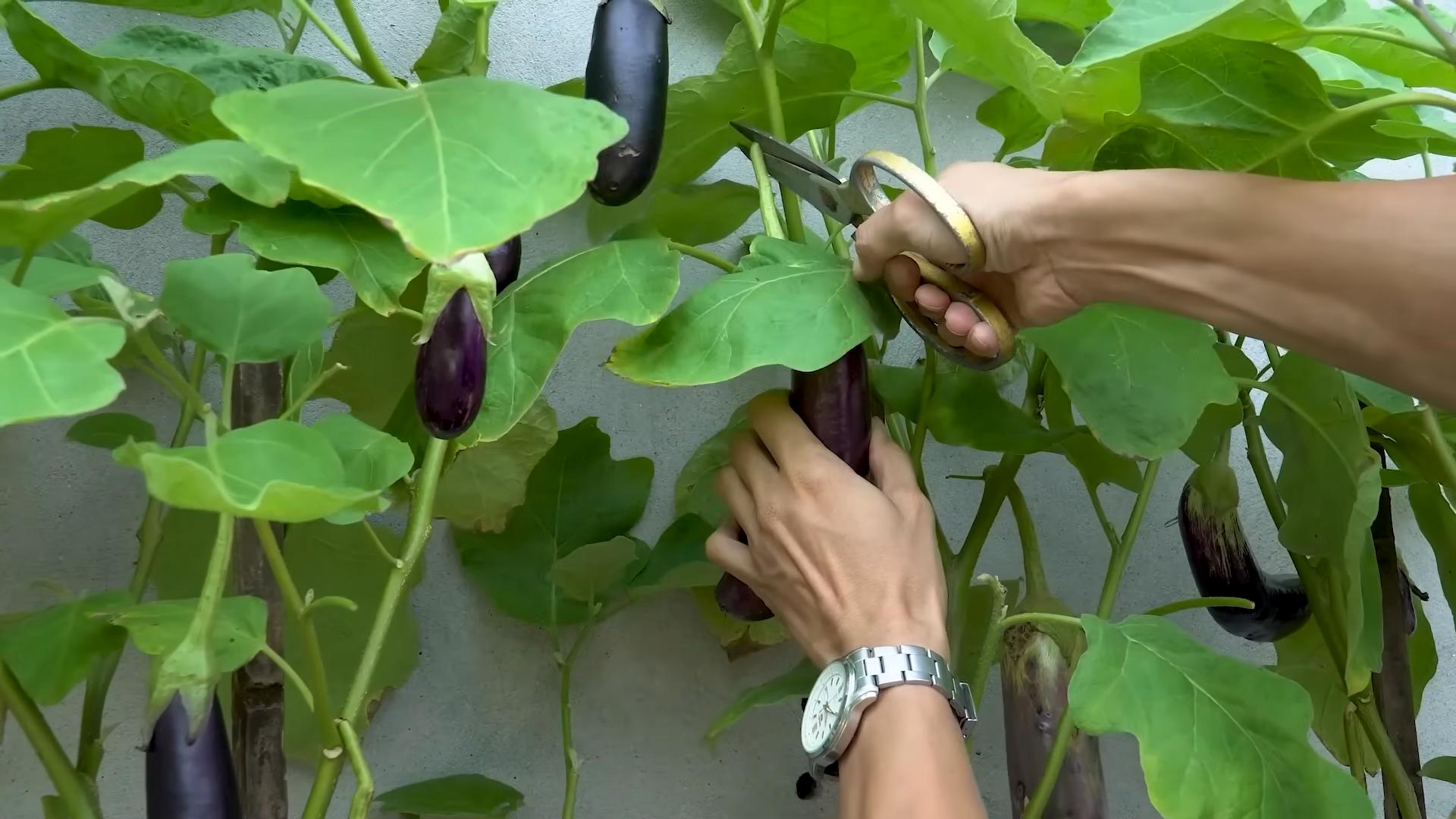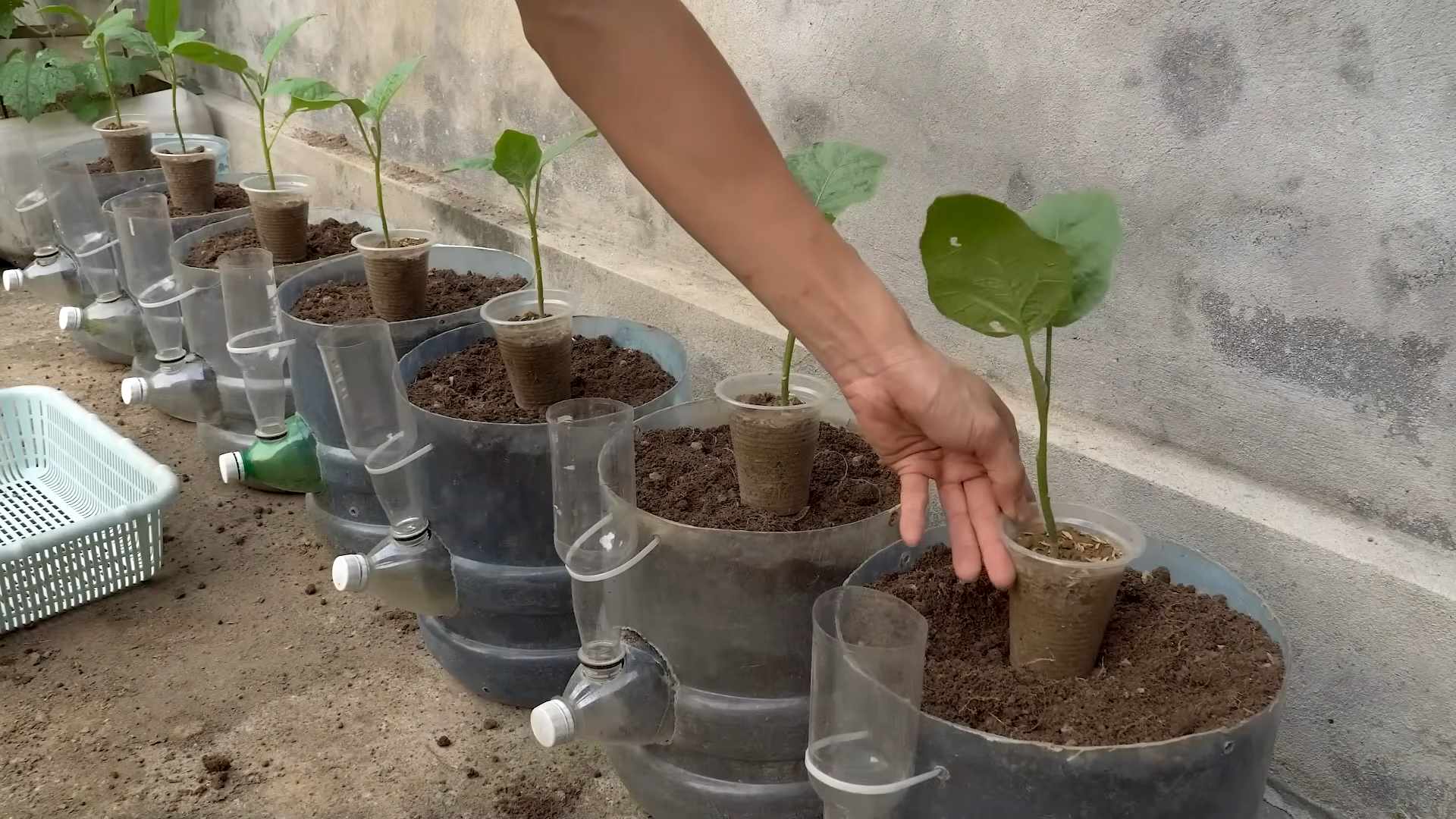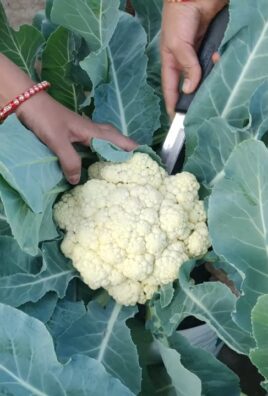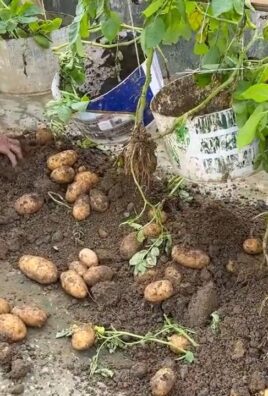Soilless Eggplant Growing might sound like something out of a sci-fi movie, but trust me, it’s a totally achievable and incredibly rewarding way to cultivate these delicious vegetables right in your own home! Forget lugging around heavy bags of soil and battling unpredictable garden conditions. I’m going to show you how to unlock the secrets of hydroponics and other soil-free methods to produce a bumper crop of eggplants, even if you have limited space or a less-than-green thumb.
Eggplants, with their rich history tracing back to ancient Asia, have been a culinary staple for centuries. From the Mediterranean’s moussaka to Asia’s stir-fries, this versatile fruit (yes, it’s technically a fruit!) has graced tables worldwide. But traditionally, growing eggplants required a lot of space and specific soil conditions. That’s where soilless growing comes in!
Why should you consider soilless eggplant growing? Well, for starters, it’s incredibly efficient. You’ll use less water, have better control over nutrients, and significantly reduce the risk of soilborne diseases. Plus, it’s perfect for apartment dwellers, balcony gardeners, or anyone who wants to extend their growing season. Imagine harvesting fresh, vibrant eggplants right from your kitchen counter! This DIY guide will walk you through everything you need to know, from choosing the right soilless system to troubleshooting common issues. Get ready to revolutionize your home gardening game and enjoy the freshest eggplants you’ve ever tasted!

DIY: Growing Eggplants Without Soil – A Hydroponic Adventure!
Hey there, fellow gardening enthusiasts! Ever thought about growing eggplants without getting your hands dirty? Well, get ready to dive into the exciting world of hydroponics! I’m going to walk you through building your own simple hydroponic system to grow delicious, healthy eggplants right at home. It’s easier than you think, and the results are incredibly rewarding.
What You’ll Need: The Shopping List
Before we get started, let’s gather our supplies. Don’t worry, you probably have some of these lying around already!
* **A Container:** This will be our reservoir for the nutrient solution. A dark-colored plastic storage bin (around 10-20 gallons) works perfectly. Dark colors help prevent algae growth.
* **Net Pots:** These are small, slotted pots that will hold your eggplant seedlings and the growing medium. 3-inch net pots are a good size.
* **Growing Medium:** We’ll use an inert medium like coco coir or clay pebbles (hydroton). These provide support for the roots without adding any nutrients. I personally prefer coco coir for eggplants.
* **Nutrient Solution:** This is the lifeblood of our hydroponic system! You’ll need a hydroponic nutrient solution specifically formulated for fruiting vegetables like eggplants. Look for a two-part solution (A & B) for optimal results.
* **Air Pump and Air Stone:** These will oxygenate the nutrient solution, which is crucial for healthy root growth.
* **Airline Tubing:** To connect the air pump to the air stone.
* **pH Meter or pH Test Kit:** Maintaining the correct pH level is essential for nutrient absorption.
* **pH Up and pH Down Solutions:** To adjust the pH of the nutrient solution.
* **Rockwool Cubes (for Seedlings):** These are small cubes of compressed rockwool that are perfect for starting seeds.
* **Eggplant Seeds:** Choose your favorite variety! I recommend starting with a compact variety that is well-suited for container growing.
* **Grow Lights (Optional but Recommended):** If you don’t have a sunny spot, grow lights will provide the necessary light for your eggplants to thrive. LED grow lights are energy-efficient and work great.
* **Timer (for Grow Lights):** To automate the lighting schedule.
* **Drill with Hole Saw Attachment:** To create holes in the container lid for the net pots.
* **Measuring Cups and Spoons:** For accurately measuring the nutrient solution.
* **Gloves:** To protect your hands.
Building Your Hydroponic System: Step-by-Step
Alright, let’s get our hands dirty (well, not really, since it’s soilless!). Here’s how to build your simple hydroponic system:
1. **Prepare the Container:** Clean the plastic storage bin thoroughly with soap and water. Rinse it well to remove any soap residue.
2. **Drill the Holes:** Place the lid on the container. Arrange the net pots on the lid, spacing them evenly. Use a pencil to trace around each net pot. Use the hole saw attachment on your drill to carefully cut out the holes. Make sure the holes are slightly smaller than the diameter of the net pots so they sit snugly.
3. **Assemble the Air System:** Connect the airline tubing to the air pump and the air stone. Place the air stone at the bottom of the container. This will oxygenate the nutrient solution.
4. **Prepare the Growing Medium:** If you’re using coco coir, rinse it thoroughly with water to remove any excess salts. If you’re using clay pebbles, rinse them as well to remove any dust.
5. **Prepare the Seedlings:** This is a crucial step. You can either start your eggplant seeds directly in rockwool cubes or transplant seedlings from soil. I prefer starting in rockwool.
* **Starting from Seed:** Soak the rockwool cubes in water for a few minutes. Gently squeeze out the excess water. Place one or two eggplant seeds in the small hole in the top of each cube. Place the cubes in a tray and cover them with a humidity dome or plastic wrap to create a humid environment. Keep the cubes moist but not soggy. Once the seedlings emerge (usually within a week), remove the dome and provide them with light.
* **Transplanting Seedlings:** If you’re transplanting seedlings from soil, gently remove them from their pots, being careful not to damage the roots. Rinse off as much soil as possible.
6. **Fill the Net Pots:** Place the net pots into the holes in the container lid. Fill each net pot with the prepared growing medium (coco coir or clay pebbles).
7. **Transplant the Seedlings (or Place Rockwool Cubes):** If you started from seed, carefully place the rockwool cubes with the seedlings into the net pots, nestled among the growing medium. If you’re transplanting seedlings, gently place them into the net pots, spreading the roots among the growing medium.
8. **Prepare the Nutrient Solution:** This is where precision is key! Follow the instructions on the nutrient solution packaging carefully. Typically, you’ll mix equal parts of the A and B solutions with water. Start with a diluted solution (around half strength) for young seedlings and gradually increase the concentration as the plants grow.
9. **Fill the Reservoir:** Pour the nutrient solution into the container, making sure the bottom of the net pots are submerged in the solution. The roots will grow down into the solution.
10. **Check and Adjust the pH:** Use your pH meter or test kit to check the pH of the nutrient solution. Eggplants thrive in a pH range of 5.5 to 6.5. If the pH is too high, add a small amount of pH Down solution. If the pH is too low, add a small amount of pH Up solution. Always add the solutions gradually and recheck the pH after each adjustment.
11. **Provide Light:** If you’re growing indoors, set up your grow lights above the plants. Use a timer to provide 14-16 hours of light per day. If you’re growing outdoors, place the container in a sunny location that receives at least 6 hours of direct sunlight per day.
Maintaining Your Hydroponic Eggplants: The Nitty-Gritty
Now that your system is set up, it’s time to nurture your eggplants and watch them grow! Here’s what you need to do to keep them happy and healthy:
* **Monitor the Nutrient Solution:** Check the nutrient solution level regularly and add more as needed. Replace the entire solution every 1-2 weeks to prevent nutrient imbalances.
* **Check and Adjust the pH:** Check the pH of the nutrient solution every few days and adjust as needed to maintain the optimal range of 5.5 to 6.5.
* **Monitor for Pests and Diseases:** Keep an eye out for any signs of pests or diseases. Treat any problems promptly with appropriate organic solutions.
* **Provide Support:** As your eggplants grow, they will need support to prevent them from toppling over. Use stakes or a trellis to support the plants.
* **Prune Your Plants:** Prune away any suckers (small shoots that grow from the base of the plant) to encourage more fruit production.
* **Pollinate the Flowers:** Eggplants are self-pollinating, but you can help them along by gently shaking the plants or using a small brush to transfer pollen from one flower to another.
* **Harvest Your Eggplants:** Harvest your eggplants when they are firm and glossy. Use a sharp knife or pruners to cut the fruit from the plant.
Troubleshooting Tips: When Things Go Wrong
Even with the best planning, things can sometimes go wrong. Here are a few common problems and how to fix them:
* **Yellowing Leaves:** This could be a sign of nutrient deficiency. Check the nutrient solution concentration and pH.
* **Slow Growth:** This could be due to insufficient light, low temperatures, or nutrient deficiencies.
* **Root Rot:** This is caused by a lack of oxygen in the nutrient solution. Make sure your air pump and air stone are working properly.
* **Pests:** Common pests include aphids, spider mites, and whiteflies. Treat them with organic insecticides or insecticidal soap.
Choosing the Right Eggplant Variety
Not all eggplant varieties are created equal, especially when it comes to container gardening. Here are a few varieties that I’ve found to be particularly well-suited for hydroponic growing:
* **’Patio Baby’:** This is a compact variety that produces small, bite-sized eggplants. It’s perfect for small spaces.
* **’Fairy Tale’:** This variety produces beautiful, striped eggplants that are mild and sweet.
* **’Little Fingers’:** This variety produces long, slender eggplants that are tender and flavorful.
* **’Black Beauty’:** A classic variety, but choose a smaller, more compact version if possible.
Hydroponic Eggplant Growing: My Personal Tips
Over the years, I’ve learned a few tricks that have helped me to grow even

Conclusion
So, there you have it! Embracing soilless eggplant growing is not just a trendy gardening experiment; it’s a game-changer for anyone looking to maximize yields, minimize pests, and enjoy fresh, delicious eggplants regardless of their space constraints or soil quality. We’ve explored the simplicity and effectiveness of this method, highlighting how it bypasses many of the common challenges associated with traditional soil-based gardening.
The beauty of soilless culture lies in its adaptability. Whether you’re a seasoned gardener or a complete novice, you can tailor this technique to suit your specific needs and resources. Consider experimenting with different hydroponic systems – perhaps a simple Kratky setup for beginners, or a more advanced deep water culture (DWC) system for those seeking greater control over nutrient delivery. You can also explore various growing media, such as coco coir, perlite, or rockwool, to find the combination that works best for your climate and eggplant variety.
Don’t be afraid to get creative with your nutrient solutions, either. While pre-mixed hydroponic fertilizers are readily available, you can also explore organic options or even create your own custom blends to optimize plant growth and flavor. Remember to carefully monitor your plants and adjust nutrient levels as needed, paying close attention to signs of deficiency or toxicity.
Beyond the core techniques, consider incorporating companion planting strategies to further enhance your soilless eggplant growing experience. Marigolds, for example, can help deter pests, while basil can improve the flavor of your eggplants. Vertical gardening techniques, such as trellising or using hanging baskets, can also maximize space utilization and create a visually stunning display.
Ultimately, the key to success with soilless eggplant growing is experimentation and observation. Don’t be discouraged if you encounter challenges along the way. Every setback is an opportunity to learn and refine your techniques. The rewards – bountiful harvests of flavorful, homegrown eggplants – are well worth the effort.
We wholeheartedly encourage you to give this DIY trick a try. It’s a fantastic way to connect with nature, learn new skills, and enjoy the satisfaction of growing your own food. And most importantly, we want to hear about your experiences! Share your successes, your challenges, and your unique variations in the comments below. Let’s build a community of soilless eggplant enthusiasts and learn from each other. Your insights could inspire others to embark on their own soilless gardening journey. So, grab your seeds, gather your supplies, and get ready to experience the joy of soilless eggplant growing!
Frequently Asked Questions (FAQ)
What exactly is soilless eggplant growing, and why should I consider it?
Soilless eggplant growing, also known as hydroponics, is a method of cultivating eggplants without using traditional soil. Instead, the plants are grown in a nutrient-rich solution that provides them with all the essential elements they need to thrive. This method offers several advantages, including:
* Increased yields: Soilless systems allow for precise control over nutrient delivery, resulting in faster growth and higher yields compared to soil-based gardening.
* Reduced pest and disease problems: By eliminating soil, you also eliminate many of the soilborne pests and diseases that can plague eggplant crops.
* Water conservation: Hydroponic systems often use less water than traditional gardening methods, as the water is recirculated and reused.
* Space efficiency: Soilless growing is ideal for small spaces, such as balconies, patios, or even indoor environments.
* Improved control over growing conditions: You can easily adjust factors like temperature, humidity, and nutrient levels to optimize plant growth.
What are the different types of soilless systems I can use for growing eggplants?
There are several types of soilless systems that are well-suited for growing eggplants, each with its own advantages and disadvantages:
* Deep Water Culture (DWC): The plant roots are suspended in a nutrient-rich solution that is aerated with an air pump. This is a simple and effective system for beginners.
* Nutrient Film Technique (NFT): A thin film of nutrient solution is continuously pumped over the plant roots. This system requires a pump and a reservoir.
* Ebb and Flow (Flood and Drain): The growing tray is periodically flooded with nutrient solution and then drained. This system requires a timer and a pump.
* Drip Irrigation: Nutrient solution is delivered directly to the plant roots through a network of drip emitters. This system is efficient and easy to automate.
* Kratky Method: A passive hydroponic system where the plant sits in a reservoir of nutrient solution, and the roots gradually absorb the nutrients as the water level drops. This is a very low-maintenance option.
What kind of growing medium should I use for soilless eggplant growing?
The growing medium provides support for the plant roots and helps to retain moisture and nutrients. Some popular options for soilless eggplant growing include:
* Coco Coir: A natural fiber derived from coconut husks. It has excellent water retention and aeration properties.
* Perlite: A volcanic glass that is heated and expanded. It provides excellent drainage and aeration.
* Rockwool: A spun mineral fiber that is lightweight and has good water retention.
* Vermiculite: A mineral that expands when heated. It has good water retention and nutrient-holding capacity.
* Clay Pebbles (LECA): Lightweight expanded clay aggregate. Provides excellent drainage and aeration.
What nutrients do eggplants need when grown soillessly?
Eggplants require a balanced nutrient solution that contains all the essential elements for plant growth, including:
* Macronutrients: Nitrogen (N), Phosphorus (P), Potassium (K), Calcium (Ca), Magnesium (Mg), and Sulfur (S).
* Micronutrients: Iron (Fe), Manganese (Mn), Zinc (Zn), Copper (Cu), Boron (B), and Molybdenum (Mo).
You can purchase pre-mixed hydroponic fertilizers that are specifically formulated for vegetable crops, or you can create your own custom blend using individual nutrient salts. Be sure to follow the instructions on the fertilizer label and monitor your plants for signs of nutrient deficiency or toxicity.
How often should I water my soilless eggplants?
The watering frequency will depend on the type of soilless system you are using and the environmental conditions. In general, you should aim to keep the growing medium consistently moist but not waterlogged. Check the moisture level regularly and water as needed. With hydroponic systems like DWC, the roots are constantly in the nutrient solution, so watering isn’t a concern in the traditional sense.
What are some common pests and diseases that affect soilless eggplants, and how can I prevent them?
While soilless growing reduces the risk of soilborne pests and diseases, eggplants can still be susceptible to certain problems, such as:
* Aphids: Small, sap-sucking insects that can weaken plants and transmit diseases.
* Spider Mites: Tiny pests that create webs on the leaves and suck plant sap.
* Whiteflies: Small, white insects that feed on plant sap and excrete honeydew.
* Fungal Diseases: Such as powdery mildew and damping-off, which can thrive in humid conditions.
To prevent these problems, maintain good hygiene in your growing area, inspect your plants regularly for signs of pests or diseases, and use appropriate control measures, such as insecticidal soap, neem oil, or biological control agents.
How much light do soilless eggplants need?
Eggplants require at least 6-8 hours of direct sunlight per day to thrive. If you are growing your eggplants indoors, you will need to supplement with artificial lighting, such as LED grow lights or fluorescent lights.
How long does it take to grow eggplants soillessly?
The time it takes to grow eggplants soillessly will depend on the variety of eggplant, the growing conditions, and the type of soilless system you are using. In general, it takes about 60-80 days from transplanting to harvest.
Can I grow organic eggplants soillessly?
Yes, it is possible to grow organic eggplants soillessly. You will need to use organic growing media, organic nutrient solutions, and organic pest control methods. Look for products that are certified organic by a reputable organization, such as the Organic Materials Review Institute (OMRI).
What are some tips for maximizing yields when growing eggplants soillessly?
Here are some tips for maximizing yields when growing eggplants soillessly:
* Choose a high-yielding variety of eggplant.
* Provide adequate light, nutrients, and water.
* Maintain optimal temperature and humidity levels.
* Prune your plants to encourage branching and fruit production.
So, there you have it! Embracing soilless eggplant growing is not just a trendy gardening experiment; it’s a game-changer for anyone looking to maximize yields, minimize pests, and enjoy fresh, delicious eggplants regardless of their space constraints or soil quality. We’ve explored the simplicity and effectiveness of this method, highlighting how it bypasses many of the common challenges associated with traditional soil-based gardening.
The beauty of soilless culture lies in its adaptability. Whether you’re a seasoned gardener or a complete novice, you can tailor this technique to suit your specific needs and resources. Consider experimenting with different hydroponic systems – perhaps a simple Kratky setup for beginners, or a more advanced deep water culture (DWC) system for those seeking greater control over nutrient delivery. You can also explore various growing media, such as coco coir, perlite, or rockwool, to find the combination that works best for your climate and eggplant variety.
Don’t be afraid to get creative with your nutrient solutions, either. While pre-mixed hydroponic fertilizers are readily available, you can also explore organic options or even create your own custom blends to optimize plant growth and flavor. Remember to carefully monitor your plants and adjust nutrient levels as needed, paying close attention to signs of deficiency or toxicity.
Beyond the core techniques, consider incorporating companion planting strategies to further enhance your soilless eggplant growing experience. Marigolds, for example, can help deter pests, while basil can improve the flavor of your eggplants. Vertical gardening techniques, such as trellising or using hanging baskets, can also maximize space utilization and create a visually stunning display.
Ultimately, the key to success with soilless eggplant growing is experimentation and observation. Don’t be discouraged if you encounter challenges along the way. Every setback is an opportunity to learn and refine your techniques. The rewards – bountiful harvests of flavorful, homegrown eggplants – are well worth the effort.
We wholeheartedly encourage you to give this DIY trick a try. It’s a fantastic way to connect with nature, learn new skills, and enjoy the satisfaction of growing your own food. And most importantly, we want to hear about your experiences! Share your successes, your challenges, and your unique variations in the comments below. Let’s build a community of soilless eggplant enthusiasts and learn from each other. Your insights could inspire others to embark on their own soilless gardening journey. So, grab your seeds, gather your supplies, and get ready to experience the joy of soilless eggplant growing!
Frequently Asked Questions (FAQ)
What exactly is soilless eggplant growing, and why should I consider it?
Soilless eggplant growing, also known as hydroponics, is a method of cultivating eggplants without using traditional soil. Instead, the plants are grown in a nutrient-rich solution that provides them with all the essential elements they need to thrive. This method offers several advantages, including:
* Increased yields: Soilless systems allow for precise control over nutrient delivery, resulting in faster growth and higher yields compared to soil-based gardening.
* Reduced pest and disease problems: By eliminating soil, you also eliminate many of the soilborne pests and diseases that can plague eggplant crops.
* Water conservation: Hydroponic systems often use less water than traditional gardening methods, as the water is recirculated and reused.
* Space efficiency: Soilless growing is ideal for small spaces, such as balconies, patios, or even indoor environments.
* Improved control over growing conditions: You can easily adjust factors like temperature, humidity, and nutrient levels to optimize plant growth.
What are the different types of soilless systems I can use for growing eggplants?
There are several types of soilless systems that are well-suited for growing eggplants, each with its own advantages and disadvantages:
* Deep Water Culture (DWC): The plant roots are suspended in a nutrient-rich solution that is aerated with an air pump. This is a simple and effective system for beginners.
* Nutrient Film Technique (NFT): A thin film of nutrient solution is continuously pumped over the plant roots. This system requires a pump and a reservoir.
* Ebb and Flow (Flood and Drain): The growing tray is periodically flooded with nutrient solution and then drained. This system requires a timer and a pump.
* Drip Irrigation: Nutrient solution is delivered directly to the plant roots through a network of drip emitters. This system is efficient and easy to automate.
* Kratky Method: A passive hydroponic system where the plant sits in a reservoir of nutrient solution, and the roots gradually absorb the nutrients as the water level drops. This is a very low-maintenance option.
What kind of growing medium should I use for soilless eggplant growing?
The growing medium provides support for the plant roots and helps to retain moisture and nutrients. Some popular options for soilless eggplant growing include:
* Coco Coir: A natural fiber derived from coconut husks. It has excellent water retention and aeration properties.
* Perlite: A volcanic glass that is heated and expanded. It provides excellent drainage and aeration.
* Rockwool: A spun mineral fiber that is lightweight and has good water retention.
* Vermiculite: A mineral that expands when heated. It has good water retention and nutrient-holding capacity.
* Clay Pebbles (LECA): Lightweight expanded clay aggregate. Provides excellent drainage and aeration.
What nutrients do eggplants need when grown soillessly?
Eggplants require a balanced nutrient solution that contains all the essential elements for plant growth, including:
* Macronutrients: Nitrogen (N), Phosphorus (P), Potassium (K), Calcium (Ca), Magnesium (Mg), and Sulfur (S).
* Micronutrients: Iron (Fe), Manganese (Mn), Zinc (Zn), Copper (Cu), Boron (B), and Molybdenum (Mo).
You can purchase pre-mixed hydroponic fertilizers that are specifically formulated for vegetable crops, or you can create your own custom blend using individual nutrient salts. Be sure to follow the instructions on the fertilizer label and monitor your plants for signs of nutrient deficiency or toxicity.
How often should I water my soilless eggplants?
The watering frequency will depend on the type of soilless system you are using and the environmental conditions. In general, you should aim to keep the growing medium consistently moist but not waterlogged. Check the moisture level regularly and water as needed. With hydroponic systems like DWC, the roots are constantly in the nutrient solution, so watering isn’t a concern in the traditional sense.
What are some common pests and diseases that affect soilless eggplants, and how can I prevent them?
While soilless growing reduces the risk of soilborne pests and diseases, eggplants can still be susceptible to certain problems, such as:
* Aphids: Small, sap-sucking insects that can weaken plants and transmit diseases.
* Spider Mites: Tiny pests that create webs on the leaves and suck plant sap.
* Whiteflies: Small, white insects that feed on plant sap and excrete honeydew.
* Fungal Diseases: Such as powdery mildew and damping-off, which can thrive in humid conditions.
To prevent these problems, maintain good hygiene in your growing area, inspect your plants regularly for signs of pests or diseases, and use appropriate control measures, such as insecticidal soap, neem oil, or biological control agents.
How much light do soilless eggplants need?
Eggplants require at least 6-8 hours of direct sunlight per day to thrive. If you are growing your eggplants indoors, you will need to supplement with artificial lighting, such as LED grow lights or fluorescent lights.
How long does it take to grow eggplants soillessly?
The time it takes to grow eggplants soillessly will depend on the variety of eggplant, the growing conditions, and the type of soilless system you are using. In general, it takes about 60-80 days from transplanting to harvest.
Can I grow organic eggplants soillessly?
Yes, it is possible to grow organic eggplants soillessly. You will need to use organic growing media, organic nutrient solutions, and organic pest control methods. Look for products that are certified organic by a reputable organization, such as the Organic Materials Review Institute (OMRI).
What are some tips for maximizing yields when growing eggplants soillessly?
Here are some tips for maximizing yields when growing eggplants soillessly:
* Choose a high-yielding variety of eggplant.
* Provide adequate light, nutrients, and water.
* Maintain optimal temperature and humidity levels.
* Prune your plants to encourage branching and fruit production.
* Pollinate your flowers by hand if necessary.
* Harvest your eggplants regularly to encourage continued fruit production.





Leave a Comment